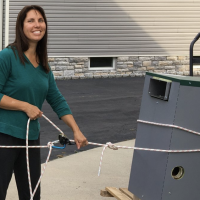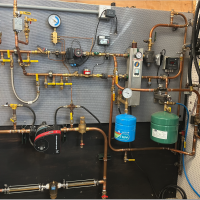Boiler shock and condensation
In order to debug a boiler problem, a few years ago, I installed temperature and zone sensors on the boiler. Which helped me figure out the problem.
This past fall I had the idea that I could disable the side arm from like midnight to 4 AM. Save some wear and tear and fuel. Not a big deal all in all.
Now that its warmed up and radiant floor is not running much, during this midnight to 4 AM off period, the boiler inlet temp dips down to maybe 90 degrees. As soon as the circulator comes on it comes right back up.
Now I'm a little concerned that I might be shooting myself in the foot. I think the minimum recommended boiler inlet is like 150 degrees.
For the 150 degree inlet temp spec, is there a duration part to that too? This 90 inlet temp period won't last long, but it will happen. This same condition could occur if I had a very well insulated side arm tank and no DHW demand for while.
The simple question is, what's the detail on the inlet temperature spec?
Comments
-
-
@_big_ , what make and model is the boiler?
All Steamed Up, Inc.
Towson, MD, USA
Steam, Vapor & Hot-Water Heating Specialists
Oil & Gas Burner Service
Consulting0 -
It Depends….If the boiler is a condensing boiler they love lower temperatures.
If you have a regular cast iron boiler they do not do very well with lower return temperatures over long periods..Issues with Flue gas condensation and corrosion to the cast iron are the first signs of a cast iron boiler operating outside of it's "comfort zone"/Below 138 F.
0 -
Saturn Series Super Hot.
And the temperature comes up as soon as the circulator comes on. Even before the boiler fires.
0 -
So it was installed as per manufactures instructions with the "Bypass valve"?
0 -
I don't know. I didn't install it. How would I identify this bypass valve?
0 -
Can you please send some pictures of the piping to the boiler.
It is a Valve that is installed between the supply and return of the boiler in order to adjust the return temperature rise.
You may be able to identify it because it may be half way Open.
0 -
There is a manually adjusted Tekmar mixing valve between the primary loop and the floor loops. Probably hard to tell from the picture, but there is a pipe tee'ed off the primary loop just before the Tekmar. This goes to the side arm. Which means its not always open and can't be some bypass path.
There is no other mixing/bypass valve in the primary loop.
0 -
Hard to tell from the picture…I am not a big fan of manually fixed 4 ways valves and none thermal activated Bypass valves !
Not sure about the piping techniques that were applied by looking at these pictures..
You MAY be able to interface a Tekmar Mixing valve actuating motor (741-743)and a Tekmar control with the existing 4 way and programm the tekmar so that it will keep your equipment from Condensing.
I am not sure of installing a actuating motor in this position ?
EDIT: Can you send some more pictures of the system from further back..I would like to see the circulating pump location!
0 -
That 4 way valve can only protect the boiler from low return temperature if it has an actuator and sensor at the boiler return piping. It may be serving dual purposes, mixing down the temperature for a low temperature radiant, and protecting the boiler.
It could also have an ODR outdoor reset function included in the control.
BUT it can do neither properly without a controller, some intelligence. As installed it is a "dumb" mixing/ protection valve.
The 4 way mix valve is an excellent valve when properly applied and set up.
A manual operated ball valve or bypass pump is also a guesstimate, set to work at only one particular condition.
Bob "hot rod" Rohr
trainer for Caleffi NA
Living the hydronic dream1 -
@ Hot_rod ….thank you for showing a drawing for this subject.
One of the issues with this setup is that some boilers such as the Superhot saturn series or the Teledyne Miniterm boiler require a minimum flow rates across the heat exchanger.
In certain situations I personally like the Two circ system(Boiler/System) or not allowing the mixing valve to close beyond a certain point so that the minimum flow rates are sadisfied and the boiler does not do jumping jacks. 🙂
EDIT… Or (In the drawing) the system circ becomes the Boiler Circ.
0 -
yes, if the smallest zone cannot meet the boilers minimum flow, you would need a primary secondary piping with an additional pump. The same would be true with an injection mixing method.
Bob "hot rod" Rohr
trainer for Caleffi NA
Living the hydronic dream0 -
Attached is a 'pano' of the boiler closet. The closet is relatively small and difficult to capture with a camera.
Figure 6.11 is fairly close to my setup except there is a side arm on the primary loop and the circulator is on the primary loop.
I've always been a bit amazed that this system gets by with a single circulator. The boiler is in the lower level of a two story structure. Most of the heating is radiant floor. Except for one zone underneath a hot tub with a small baseboard radiator underneath the tub. The highest point in the system. I've had trouble with flow through this zone while keeping the floor inlet temperature under 140 degrees. The way the Tekmar mixing valve works is the pressure in the floor zones and the temperature are directly coupled. To get more pressure, you get higher temperature. There is certainly part of me that would like to see another circulator in the floor loops.
I would be very nervous about moving the circulator to the floor zones as shown in figure 6.11. In fact it probably wouldn't work at all with the side arm.
There is no "outdoor reset". A term that I find peculiar.
0 -
The manual shows the suggested gpm and related pressure drop. Although it does not show minimum required flow?
Looks like 6 loops on each manifold? At .5 gpm per loop that would be 3 gpm flow with one zone calling
Which model do you have? That is how you would determine piping and pumping
I did not see a low temperature piping example in the online manual
Without an actuator on the valve, the boiler is always getting a % of flow But it cannot close the distribution side , so it doesn’t offer return protection. Or accurate mixing for the radiant
Probably plenty of systems are piped with un-controlled 4 way valves.
A lucky, fortunate set of circumstances allows them to run ok for years
This shows the insides, if the actuator rotated the vane CCW that would be 100% flow through the boiler, protect mode The vane slowly rotates CW as the boiler returns temperature rises
Bob "hot rod" Rohr
trainer for Caleffi NA
Living the hydronic dream0
Categories
- All Categories
- 87.3K THE MAIN WALL
- 3.2K A-C, Heat Pumps & Refrigeration
- 61 Biomass
- 429 Carbon Monoxide Awareness
- 120 Chimneys & Flues
- 2.1K Domestic Hot Water
- 5.8K Gas Heating
- 114 Geothermal
- 166 Indoor-Air Quality
- 3.7K Oil Heating
- 77 Pipe Deterioration
- 1K Plumbing
- 6.5K Radiant Heating
- 395 Solar
- 15.7K Strictly Steam
- 3.4K Thermostats and Controls
- 56 Water Quality
- 51 Industry Classes
- 50 Job Opportunities
- 18 Recall Announcements







